Eliza Knight's Blog, page 42
February 14, 2013
Blythe Gifford – In which we create a Happy Ending (+Giveaway!)
 Welcome back to History Undressed, guest author Blythe Gifford! She writes wonderful historical romance novels, and has a fascinating piece for us today! Enjoy! (Leave a comment with your email address for your chance to win!)
Welcome back to History Undressed, guest author Blythe Gifford! She writes wonderful historical romance novels, and has a fascinating piece for us today! Enjoy! (Leave a comment with your email address for your chance to win!)
Blythe Gifford – In which we create a Happy Ending
On February 19, TAKEN BY THE BORDER REBEL, the final book in The Brunson Clan trilogy, hits the shelves. And with its publication, I’ll achieve my goal in writing the series: To give Johnnie Armstrong a happy ending.
Let me explain.
The trilogy is set on the Scottish Borders during the early Tudor era. Constant war, along with a bleak, hilly terrain ill-suited to settled agriculture, and inheritance laws that split land into smaller and smaller parcels all combined to make it difficult to keep body and soul together.
This was the land of the Border Reivers. To survive, the Reivers, a term applicable to both English and Scottish families, “made a living” by stealing from one another, or, alternately, by collecting “blackmail” from those who could pay to be left alone. Whether there was a formal war or an uneasy peace, the Borders were, in effect, a war zone for 300 years.
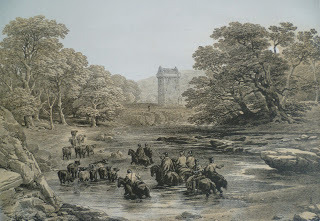 The “war” was only marginally between Scotland and England. More often, it was among the various families on either side of the dividing line. Loyal to family above king, these folks had feuds that rivaled the famous Hatfields and McCoys They were beyond the law of either government, and usually even beyond the reach of the special Border Laws that were developed in a joint Anglo-Scots effort to bring order from the chaos.
The “war” was only marginally between Scotland and England. More often, it was among the various families on either side of the dividing line. Loyal to family above king, these folks had feuds that rivaled the famous Hatfields and McCoys They were beyond the law of either government, and usually even beyond the reach of the special Border Laws that were developed in a joint Anglo-Scots effort to bring order from the chaos. Amidst all this brutality, however, the Borders produced songs that we still remember, thanks in large measure to Sir Walter Scott. As A.L. Lloyd said in FOLK SONG IN ENGLAND, the Reivers “prized a poem almost as much as plunder, and produced such an impressive assembly of local narrative songs that some people used to label all our greater folk poems as 'Border ballads'."
“The Ballad of Johnnie Armstrong,” the story of an execution of a famous Border Reiver, was one of these.
Now Johnnie Armstrong, or Johnnie of Gilnocke, as he was also called, was one of the most notorious Reivers on the Borders. Finally, King James V of Scotland rode into the land himself in a desperate attempt to restore order to the most lawless ground on the island. (Some suggest he did it because he had something to prove to his uncle, King Henry VIII of England.) At the top of King James’ list was Johnnie Armstrong, also called the “King of the Borders.”
Of course, history is written, or rewritten, by the storytellers. To the king and the people he preyed on, Johnnie Armstrong might be a despicable man. But to the songwriter who penned the “Ballad of Johnnie Armstrong,” his hero was a gallant thief, protecting Scotland from the English, and just trying to make his way in the world. According to the balladeer, Johnnie was not lawfully tried and convicted, but basely murdered when he was lured to a meeting with the king by a “loving letter” that insisted he come unarmed.
He did exactly that, along with forty retainers, dressed in their finest splendor to honor the king, expecting to be welcomed with open arms and royal hospitality.
Instead, he and his crew were seized by the king’s men labeled traitors, and fitted with hanging nooses. Armstrong bargained for his life, and that of his men, with everything he could think of.
He offered the king all manner of gifts, including “four and twenty milk white steeds” if he were spared. His final offer was that the king should receive yearly rent, more accurately, the “blackmail” from all dwellers in the area of the Borders where Johnnie held sway, from “Gilnockie to Newcastleton.”
The king had no sympathy and was not open to a bribe.
Facing death, Johnnie made an impassioned speech, claiming he had never harmed a Scot, but only the English. The truth of this claim might be open to dispute. To the local people he had preyed upon, Johnnie’s death might have been a welcome relief. But it is also hard to summon sympathy for the king as he is portrayed in the ballad, so deceitful that he tricks his subject into a trap. The song also suggests the king was jealous of Johnnie’s fine clothes, another less than admirable trait, and perhaps even his title of “King of the Border.”
Finally, as he realizes he is to die, Johnnie says (according to the ballad) “I have asked grace at a graceless face, but there is none for my men and me.”
So poor Johnnie and his men were hanged and lived no more. Neither, legend has it, did the trees from which they swung.
Well, that didn’t seem right. So began the story of the Brunson Clan. Oh, my Brunsons are NOT the Armstrongs. Indeed, finding the “real story” behind the ballad proved that the stories live longer than the truth. So I told it my way, which mean changing virtually everything. But finally, at the end of TAKEN BY THE BORDER REBEL, the king appears, ready to punish the Brunsons and…
Well, let’s just say no trees die at the end of the book except those that provided the paper.
So, are you a sucker for a happy ending?
A lucky reader who comments on today’s blog will be randomly selected to win a signed copy of (your choice) RETURN OF THE BORDER WARRIOR (Book 1), CAPTIVE OF THE BORDER LORD (Book 2), or TAKEN BY THE BORDER REBEL (Book 3). US and Canadian addresses only, please.
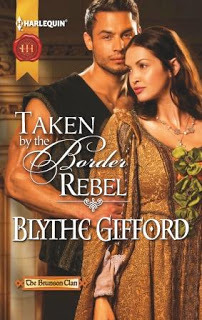 Book Three of the Brunson Clan Trilogy
TORMENTED BY HER INNOCENCE
Book Three of the Brunson Clan Trilogy
TORMENTED BY HER INNOCENCE
As leader of his clan, Black Rob Brunson has earned every dark syllable of his name. But, having taken hostage his enemy’s daughter in a fierce act of rebellion, he is tormented by feelings of guilt and torn apart with the growing need to protect her—and seduce her!
Stella Storwick feels Rob’s disdain from the first. Then slowly she starts to see behind his eyes to a man in turmoil. Something he has no words for, something that can only be captured in a heart-wrenching kiss....
March 2013Harlequin HistoricalsTM
ISBN#978-0-373-29730-6
“Each story in the series becomes more powerful than the one before, as readers become invested in the characters and their struggle to remain sovereign. The historical backdrop enhances this captive/captor romance that is at once emotionally powerful, tender and exciting.” 4-Stars, RT Book ReviewsBlythe Gifford has been known for medieval romances featuring characters born on the wrong side of the royal blanket. Now, she’s launched a Harlequin Historical trilogy set on the turbulent Scottish Borders of the early Tudor era: RETURN OF THE BORDER WARRIOR, November 2012; CAPTIVE OF THE BORDER LORD, January 2013; and TAKEN BY THE BORDER REBEL , March 2013. The Chicago Tribune has called her work "the perfect balance between history and romance." Visit her at www.blythegifford.com, www.facebook.com/BlytheGifford, www.twitter.com/BlytheGifford, or www.pinterest.com/BlytheGifford.
Cover art and copy text © 2013 by Harlequin Enterprises Limited; Cover art& copy text used by arrangement with Harlequin Enterprises Limited; ® and ™ are trademarks owned by Harlequin Enterprises Limited or its affiliated companies, used under license. Author photo by Jennifer Girard.
Published on February 14, 2013 04:02
February 13, 2013
Castle of the Week: Blyth Castle by J Tullos Hennig
'Tis Wednesday! And that means that we have another castle of the week for you here on History Undressed! Today's castle is presented to us by historical author, J Tullos Hennig. Her new book Greenwode looks very interesting!
BLYTH CASTLE: The Perfect FitJ Tullos Hennig
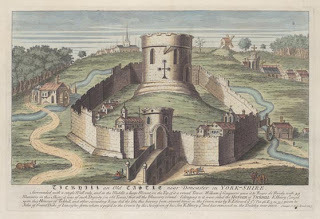
Needed: a castle for a young, ballad-inspired nobleman in the late 12th century. A place with just enough recorded history to set its significance in that specific timeframe—while, at the same time, be not so overdrawn and exposed that its history would have to be twisted past all recognition and to the chagrin of historically-minded readers... (Yes, you know who you are... and I'm one of you.)
Tickhill Castle, also known as Blyth (or Blythe), filled the need.
After all, when you're trying to breath new life into an old warhorse of a myth—the Robin Hood legend—you can't be altogether satisfied with same ol'-same old'. Familiarity is comforting, but it can certainly breed the proverbial contempt. So, while choosing the commonly-used 12th century connection was not a difficult call for someone whose favourite movie is The Lion in Winter, there were many other options to explore. I don't really have a big killer dog in any fight about Who Robyn Actually Was, but I do have a long-held personal conviction that when "Robyn Hode in Grenwode stode", it was likely not just in Sherwood Forest but also in the Peak, in Barnsdale, in Loxley Chase. Yes, 'my' Robyn is a Yorkshireman. But not a nobleman. So why would he need a castle?
Enter another lad, also inspired by legend and one who, unlike Robyn, is unquestionably a nobleman: Gamelyn Boundys. For his evolution into Robyn's (and Marion's) friend and, eventually, lover, Gamelyn needed a background against which the conflicts between peasant and noble could be seriously explored. Moreover, he needed a place to live!

So. Blyth Castle. It was well established by the 12th century, erected by one of William the Conqueror's favourites, Roger de Busli. De Busli did well out of the Norman Conquest. He was no minor nobleman, holding over 200 manors in not only Yorkshire, but Nottinghamshire. From his Yorkshire estates--those bordered by the Pennines to the west, the Humber marshes to the east, and Sherwood Forest sprawling south--de Busli raised a keep on one of the only (smallish) hillocks in the area. It was not a naturally defensible place. A full two-thirds of the earthen hill upon which the keep would stand had to be brought in, by the cartloads. (In itself quite a statement of power and wealth, particularly if one knows how much fill dirt can cost even when aided by modern equipment!) It was platted in the standard of the time, motte and bailey construction; from the air it would have resembled a figure eight, with the motte at its head and the larger loop of the bailey spreading below. It was, in every sense, a boundary castle. But it wasn't on a boundary, not really, not like Scotland or Wales or the frontiers of Normandy. Why go to so much trouble to cobble together a defense between two shires?
Well, that sort of comes back around to those Yorkshire folk. They were some of the hardest nuts Willy Bastard had to crack. They were tenacious about their land and their ways; the blood of Vikings and fierce Brigantes ran in their blood. The Conqueror responded to this with... well... more conquering. He employed not only scorched earth policies, but encouraged the raising of Norman forts wherever possible to quell rebellion. So it makes sense that Blyth Castle was likely one of those forts, placed so the Normans could attempt to exert some control over the unruly, stubbornly-independent denizens of Yorkshire. Being the midpoint in any journey along the Great North Road to York certainly was another advantage for Blyth. Location, location, location—it was no less important in medieval times than nowadays.
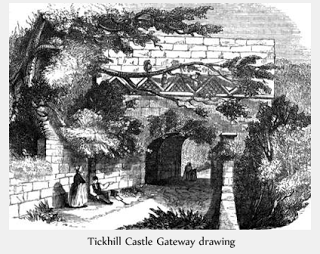
There's also the delicious fact that Blyth itself was the centre of not just one, but several outbreaks of rebellion. The first of them came when Robert de Belesme, who likely fortified Blyth with her circular foundations, (like to nearby Conisbrough and a change from the squared-off early Norman standard) and held Blyth against Henry I. It was also a stronghold later in the century for supporters of Prince John's bid for his absent brother's throne. Those supporters held not only Blyth but also Nottingham against Richard's armies when Richard returned to England, fresh from captivity, to reclaim his kingdom.
Another qualification: Blyth lies within reasonable distance of Loxley (a favoured place for Robyn Hood's birth), about 15 miles. Near enough for the castle to perhaps wield some authority over the inhabitants, but not so near that the authority was immediate, or that visiting could be done on a whim. Not only that, but Blyth gets a nod in the Robin Hood legend. It is actually in A Lytell Geste of Robyn Hode, one of the oldest surviving tales. The first of several mentions is here:
"I graunte," he sayde, "with you to wende,
My bretherne, all in fere;
My purpos was to have dyned to day
At Blith or Dancastere."
Whereas lies another point of interest. Blyth, much like legendary outlaws, is rather its own conundrum. The name of Blyth is, without warning and in many older texts, used interchangeably with that of Tickhill. The towns of Blyth and Tickhill proper are some four miles apart, not a terrible distance by any means, but a small stretch of the legs by medieval standards. Blyth is a castle. Or perhaps merely a monastery. Blyth had a amazing tournament field. Or perhaps that was Tickhill. Perhaps the tourney field was between Tickhill and Blyth. Perhaps it was at Tickhill, also called Blyth. Tickhill was in Nottinghamshire... or was it? There is good evidence to suggest that Tickhill bided in Yorkshire at one time. The shire borders of Norman England were notoriously fluid, depending on what lord decided what land was his at what time.
So, as we all must do when we sift through those biased reports of conquerors also known as History, I improvised. A depth and understanding of history is very important, even in a Historical Fantasy where pagan magic curls from around the corners, but if documentation bogs down and gets in the way of a good story then no one wins, author or reader. I sifted through accounts, recent photos and old lithographs (some of which I'll share here), built a history, a family's place and personal markers atop the facts. There was enough to me that suggested Tickhill was known as Blyth, that Blyth could easily have been the antiquarian term for the castle proper, as well as the surrounding Honour/Manor around a sixty-foot sandstone redoubt known as Tickhill—'t' wick hill', in common parlance. There were hints, here and there, that the castle had changed guardians more than once after its construction. Enough to people it with fictional inhabitants and make them—and it—more real to one another. It was a boundary castle, which neatly fell into the meaning of Gamelyn's last name, Boundys, which by most sources is understood to mean 'boundary lord'. It would have been a prime assignment to any nobleman, and no little honour for an older man: a well-settled plum of a fiefdom in which he could semi-retire and oversee his sons to defend his holding.
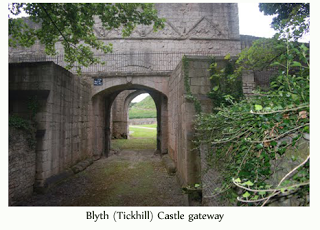
Blyth had by the mid-1100s become a popular stop-off for travellers, which boded well for the ones supporting and supported by the castle, garnering market revenues, trade and news. When Richard I brought back the tournaments that his father had banned, Blyth was one of the approved sites—indeed, the lands of Blyth and Tickhill were the only tournament grounds allowed for within the whole of England north of the River Trent. Which meant more visitors, more revenue, more goods traded and sold.
And by the end of the 12th century, Blyth was fated to become a hotbed of siege and intrigue. Which leaves a rich field yet to be mined.
What's not to like? Blyth definitely was my castle of choice for a duology of Robyn Hood.
======================================(Some of the most important references consulted for this article were The Castles and Abbeys of Yorkshire, by William Grainge, Power, Community, & Fortification in Medieval England by O.H. Creighton, The reign of William Rufus and the accession of Henry I, Vol. 2 by Edward Augustus Freeman. And, of course, the ballads A Lyttel Geste of Robyn Hode, Robin Hood and Guy of Gisbourne, and A Tale of Gamelyn.)
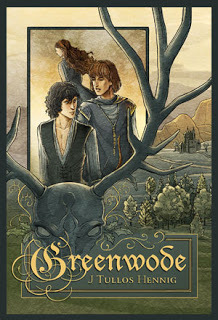 GREENWODE
by J Tullos Hennig
This new perspective on the legend of Robin Hood
brings a startling new twist to a timeless tale of fantasy, history, and romance, of myth, magic and ancient ballad.
GREENWODE
by J Tullos Hennig
This new perspective on the legend of Robin Hood
brings a startling new twist to a timeless tale of fantasy, history, and romance, of myth, magic and ancient ballad.
The Hooded One. The one to breath the dark and light and dusk between...When an old druid foresees this harbinger of chaos, he also sees whom it will claim: young Rob of Loxley. Rob and his sister Marion have been raised beneath a solemn duty: to take their parents’ places in the Old Religion, manifestations of the Horned Lord and the Lady Huntress. But when Gamelyn Boundys, son of a powerful nobleman and devout Catholic, is injured in the forest, he, Rob and Marion begin a friendship that challenges both duty and ideology. The old druid has foreseen that Gamelyn is the one destined as Rob's sworn enemy—to fight in blood sacrifice for the greenwode's Maiden.In a risky bid for happiness, Rob dares the Horned Lord to reinterpret the ancient rites—allow Rob to take Gamelyn as lover instead of rival. But in the eyes of Gamelyn’s church, lust is a sin—and sodomy is unthinkable.
LINKS:
Author Website: www.jtulloshennig.net
Amazon
Barnes &Noble
DreamspinnerPress
BLYTH CASTLE: The Perfect FitJ Tullos Hennig

Needed: a castle for a young, ballad-inspired nobleman in the late 12th century. A place with just enough recorded history to set its significance in that specific timeframe—while, at the same time, be not so overdrawn and exposed that its history would have to be twisted past all recognition and to the chagrin of historically-minded readers... (Yes, you know who you are... and I'm one of you.)
Tickhill Castle, also known as Blyth (or Blythe), filled the need.
After all, when you're trying to breath new life into an old warhorse of a myth—the Robin Hood legend—you can't be altogether satisfied with same ol'-same old'. Familiarity is comforting, but it can certainly breed the proverbial contempt. So, while choosing the commonly-used 12th century connection was not a difficult call for someone whose favourite movie is The Lion in Winter, there were many other options to explore. I don't really have a big killer dog in any fight about Who Robyn Actually Was, but I do have a long-held personal conviction that when "Robyn Hode in Grenwode stode", it was likely not just in Sherwood Forest but also in the Peak, in Barnsdale, in Loxley Chase. Yes, 'my' Robyn is a Yorkshireman. But not a nobleman. So why would he need a castle?
Enter another lad, also inspired by legend and one who, unlike Robyn, is unquestionably a nobleman: Gamelyn Boundys. For his evolution into Robyn's (and Marion's) friend and, eventually, lover, Gamelyn needed a background against which the conflicts between peasant and noble could be seriously explored. Moreover, he needed a place to live!

So. Blyth Castle. It was well established by the 12th century, erected by one of William the Conqueror's favourites, Roger de Busli. De Busli did well out of the Norman Conquest. He was no minor nobleman, holding over 200 manors in not only Yorkshire, but Nottinghamshire. From his Yorkshire estates--those bordered by the Pennines to the west, the Humber marshes to the east, and Sherwood Forest sprawling south--de Busli raised a keep on one of the only (smallish) hillocks in the area. It was not a naturally defensible place. A full two-thirds of the earthen hill upon which the keep would stand had to be brought in, by the cartloads. (In itself quite a statement of power and wealth, particularly if one knows how much fill dirt can cost even when aided by modern equipment!) It was platted in the standard of the time, motte and bailey construction; from the air it would have resembled a figure eight, with the motte at its head and the larger loop of the bailey spreading below. It was, in every sense, a boundary castle. But it wasn't on a boundary, not really, not like Scotland or Wales or the frontiers of Normandy. Why go to so much trouble to cobble together a defense between two shires?
Well, that sort of comes back around to those Yorkshire folk. They were some of the hardest nuts Willy Bastard had to crack. They were tenacious about their land and their ways; the blood of Vikings and fierce Brigantes ran in their blood. The Conqueror responded to this with... well... more conquering. He employed not only scorched earth policies, but encouraged the raising of Norman forts wherever possible to quell rebellion. So it makes sense that Blyth Castle was likely one of those forts, placed so the Normans could attempt to exert some control over the unruly, stubbornly-independent denizens of Yorkshire. Being the midpoint in any journey along the Great North Road to York certainly was another advantage for Blyth. Location, location, location—it was no less important in medieval times than nowadays.

There's also the delicious fact that Blyth itself was the centre of not just one, but several outbreaks of rebellion. The first of them came when Robert de Belesme, who likely fortified Blyth with her circular foundations, (like to nearby Conisbrough and a change from the squared-off early Norman standard) and held Blyth against Henry I. It was also a stronghold later in the century for supporters of Prince John's bid for his absent brother's throne. Those supporters held not only Blyth but also Nottingham against Richard's armies when Richard returned to England, fresh from captivity, to reclaim his kingdom.
Another qualification: Blyth lies within reasonable distance of Loxley (a favoured place for Robyn Hood's birth), about 15 miles. Near enough for the castle to perhaps wield some authority over the inhabitants, but not so near that the authority was immediate, or that visiting could be done on a whim. Not only that, but Blyth gets a nod in the Robin Hood legend. It is actually in A Lytell Geste of Robyn Hode, one of the oldest surviving tales. The first of several mentions is here:
"I graunte," he sayde, "with you to wende,
My bretherne, all in fere;
My purpos was to have dyned to day
At Blith or Dancastere."
Whereas lies another point of interest. Blyth, much like legendary outlaws, is rather its own conundrum. The name of Blyth is, without warning and in many older texts, used interchangeably with that of Tickhill. The towns of Blyth and Tickhill proper are some four miles apart, not a terrible distance by any means, but a small stretch of the legs by medieval standards. Blyth is a castle. Or perhaps merely a monastery. Blyth had a amazing tournament field. Or perhaps that was Tickhill. Perhaps the tourney field was between Tickhill and Blyth. Perhaps it was at Tickhill, also called Blyth. Tickhill was in Nottinghamshire... or was it? There is good evidence to suggest that Tickhill bided in Yorkshire at one time. The shire borders of Norman England were notoriously fluid, depending on what lord decided what land was his at what time.
So, as we all must do when we sift through those biased reports of conquerors also known as History, I improvised. A depth and understanding of history is very important, even in a Historical Fantasy where pagan magic curls from around the corners, but if documentation bogs down and gets in the way of a good story then no one wins, author or reader. I sifted through accounts, recent photos and old lithographs (some of which I'll share here), built a history, a family's place and personal markers atop the facts. There was enough to me that suggested Tickhill was known as Blyth, that Blyth could easily have been the antiquarian term for the castle proper, as well as the surrounding Honour/Manor around a sixty-foot sandstone redoubt known as Tickhill—'t' wick hill', in common parlance. There were hints, here and there, that the castle had changed guardians more than once after its construction. Enough to people it with fictional inhabitants and make them—and it—more real to one another. It was a boundary castle, which neatly fell into the meaning of Gamelyn's last name, Boundys, which by most sources is understood to mean 'boundary lord'. It would have been a prime assignment to any nobleman, and no little honour for an older man: a well-settled plum of a fiefdom in which he could semi-retire and oversee his sons to defend his holding.

Blyth had by the mid-1100s become a popular stop-off for travellers, which boded well for the ones supporting and supported by the castle, garnering market revenues, trade and news. When Richard I brought back the tournaments that his father had banned, Blyth was one of the approved sites—indeed, the lands of Blyth and Tickhill were the only tournament grounds allowed for within the whole of England north of the River Trent. Which meant more visitors, more revenue, more goods traded and sold.
And by the end of the 12th century, Blyth was fated to become a hotbed of siege and intrigue. Which leaves a rich field yet to be mined.
What's not to like? Blyth definitely was my castle of choice for a duology of Robyn Hood.
======================================(Some of the most important references consulted for this article were The Castles and Abbeys of Yorkshire, by William Grainge, Power, Community, & Fortification in Medieval England by O.H. Creighton, The reign of William Rufus and the accession of Henry I, Vol. 2 by Edward Augustus Freeman. And, of course, the ballads A Lyttel Geste of Robyn Hode, Robin Hood and Guy of Gisbourne, and A Tale of Gamelyn.)
 GREENWODE
by J Tullos Hennig
This new perspective on the legend of Robin Hood
brings a startling new twist to a timeless tale of fantasy, history, and romance, of myth, magic and ancient ballad.
GREENWODE
by J Tullos Hennig
This new perspective on the legend of Robin Hood
brings a startling new twist to a timeless tale of fantasy, history, and romance, of myth, magic and ancient ballad.The Hooded One. The one to breath the dark and light and dusk between...When an old druid foresees this harbinger of chaos, he also sees whom it will claim: young Rob of Loxley. Rob and his sister Marion have been raised beneath a solemn duty: to take their parents’ places in the Old Religion, manifestations of the Horned Lord and the Lady Huntress. But when Gamelyn Boundys, son of a powerful nobleman and devout Catholic, is injured in the forest, he, Rob and Marion begin a friendship that challenges both duty and ideology. The old druid has foreseen that Gamelyn is the one destined as Rob's sworn enemy—to fight in blood sacrifice for the greenwode's Maiden.In a risky bid for happiness, Rob dares the Horned Lord to reinterpret the ancient rites—allow Rob to take Gamelyn as lover instead of rival. But in the eyes of Gamelyn’s church, lust is a sin—and sodomy is unthinkable.
LINKS:
Author Website: www.jtulloshennig.net
Amazon
Barnes &Noble
DreamspinnerPress
Published on February 13, 2013 04:51
February 11, 2013
Romance Book Review: Emma's Journey by Callie Hutton
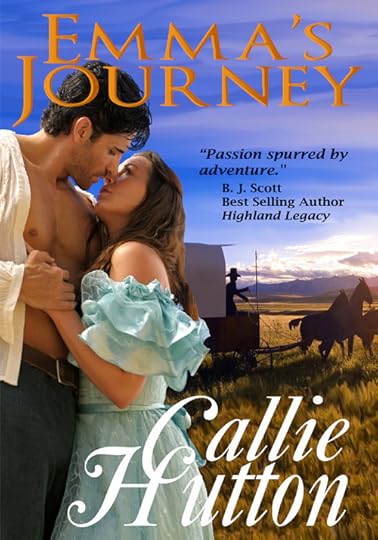 Emma's Journey
Emma's JourneyBy Callie HuttonReview by Morgan Wyatt
About the Book:
Releasing February 15th, 2013
Now that Emma Thorpe’s husband has been killed on the wagon train to Oregon, she wants to return to Indiana, but the wagon master has forced her to marry Wagon Scout, Davis Cooper. He wants to make their marriage work; she intends to flee as soon as they arrive at their destination.
Emma Thorpe did not want to leave her life in Indiana to travel to Oregon on a wagon train, but her husband Peter had other ideas. Barely three weeks into the trip Peter is killed, and Emma is shocked that the wagon master won’t let her return home.
Wagon Scout Davis Cooper has decided this would be his last scouting trip, he intends to obtain land in the new Oregon territory, find a wife, and start a family.
When the Wagon Master orders Emma to marry Davis she rebels, but eventually comes to realize she can’t go it alone, no matter how stubborn she is. But nothing will make her give up her dream to return home.
Can Davis change her mind, and have the life he’s always wanted with his unexpected wife?
Morgan's Review:
Emma’s Journey by Callie Hutton is much more than a historical romance. It is a tale of the grit and determination of the earlier settlers who chose to head west. Emma, the heroine didn’t intend to go west leaving her home and family in Indiana, but her husband Peter has other ideas.
Emma tables her reservations about joining the wagon train aware her husband is anxious to make a fresh start somewhere else. Weeks into the trip, not only it is harder than she imagined, but it becomes even harder. Peter dies trying to control a spooked horse, leaving Emma alone. Devastated, she buries Peter along the trail and asks for an escort back home. Her request shows her innocence that the wagon train, can stop, and honor her request.
Davis Cooper is hurt trying to save Peter from the out of control horse. The wagon train boss puts him in Emma’s wagon to care for until he can get back on his feet. The uptight woman secretly amuses him, but he does appreciate her care. He finds himself helping Emma with her wagon. He admires her pluck, and endurance, despite the fact she makes no secret of her desire to return to Indiana.
Life is difficult crossing the rugged terrain, and impossible for a woman alone as Emma quickly finds out. If she drops out of the train, she’ll surely perish. Only Davis Cooper’s continual help keeps her going, but a single woman can’t keep accepting the help, or companionship of a single male. His solution is marriage. How can she marry a stranger, especially when she just buried a previous husband? Even though she finds herself drawn to him, accepting her proposal will put her back in the same uncomfortable position she had with Peter traveling to a place she doesn’t want to settle.
Emma is a dynamic character who grows through her various hardships. Davis Cooper is an emotionally wounded individual who finds solace in Emma. The antagonist of the entire tale is the trail itself. Miss Hutton goes into detail to show the various difficulties of the wagon train members. It is a man against nature conflict that has you rooting for Emma, and the other wagon train members.
Emma’s Journey is a historical romance, but also is a journal of the hardships the early western settlers faced. This sweet romance should appeal to historical romance and romance fans alike.
Published on February 11, 2013 04:36
February 8, 2013
Win a Signed Print Copy of The Highlander's Lady!
.goodreadsGiveawayWidget { color: #555; font-family: georgia, serif; font-weight: normal; text-align: left; font-size: 14px; font-style: normal; background: white; } .goodreadsGiveawayWidget img { padding: 0 !important; margin: 0 !important; } .goodreadsGiveawayWidget a { padding: 0 !important; margin: 0; color: #660; text-decoration: none; } .goodreadsGiveawayWidget a:visted { color: #660; text-decoration: none; } .goodreadsGiveawayWidget a:hover { color: #660; text-decoration: underline !important; } .goodreadsGiveawayWidget p { margin: 0 0 .5em !important; padding: 0; } .goodreadsGiveawayWidgetEnterLink { display: block; width: 150px; margin: 10px auto 0 !important; padding: 0px 5px !important; text-align: center; line-height: 1.8em; color: #222; font-size: 14px; font-weight: bold; border: 1px solid #6A6454; -moz-border-radius: 5px; -webkit-border-radius: 5px; font-family:arial,verdana,helvetica,sans-serif; background-image:url(http://www.goodreads.com/images/layou... background-repeat: repeat-x; background-color:#BBB596; outline: 0; white-space: nowrap; } .goodreadsGiveawayWidgetEnterLink:hover { background-image:url(http://www.goodreads.com/images/layou... color: black; text-decoration: none; cursor: pointer; }
Goodreads Book Giveaway The Highlander's Lady by Eliza Knight Giveaway ends February 22, 2013.
The Highlander's Lady by Eliza Knight Giveaway ends February 22, 2013.
See the giveaway details at Goodreads. Enter to win
Goodreads Book Giveaway
 The Highlander's Lady by Eliza Knight Giveaway ends February 22, 2013.
The Highlander's Lady by Eliza Knight Giveaway ends February 22, 2013. See the giveaway details at Goodreads. Enter to win
Published on February 08, 2013 11:57
February 7, 2013
Victoria Roberts' X Marks the Scot
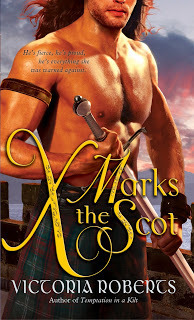 Welcome back to History Undressed, my good friend and fellow Scottish romance author, Victoria Roberts! Her latest release, X Marks the Scot is an adventurous tale with a hero that will both charm you with his bad boy ways and a heroine you'll admire. I'm in the midst of it now, and just loving it! Leave a comment for you chance to win a copy!
Welcome back to History Undressed, my good friend and fellow Scottish romance author, Victoria Roberts! Her latest release, X Marks the Scot is an adventurous tale with a hero that will both charm you with his bad boy ways and a heroine you'll admire. I'm in the midst of it now, and just loving it! Leave a comment for you chance to win a copy!
It’s wonderful to be back at History Undressed. Thanks so much for having me, Eliza Knight!
With my new release, X Marks the Scot, I had a lot of fun making Declan MacGregor the bad boy he was meant to be. Every comment, every move, I had to think like an arrogant man. Sometimes it was downright exhausting. Declan often took things over-the-top. After all, he’s emotionally scarred, headstrong, arrogant and reckless, which made for a rather interesting combination. Here’s a prime example in the excerpt below. “Praise the saints for small favors. What did ye bribe the maids with to have it cleaned so quickly?” She shook her head. “Ne’er mind. I donna want to know. I think I am able to manage now on my own. Ye can wait outside.”
Closing the distance between them, he peered down at her intently. “’Tisnae as much fun if I wait outside,” he murmured with a wanton purpose. His hot gaze slid over her body.
Her breath quickened and her tongue darted out to wet her lips. “MacGregor, I donna understand ye.” “’Tis naught to understand, healer.”
“Why do ye behave this way?”
He was about to answer when she held up her hand to stay him.
“’Tis as if ye are two completely different men. One man is an arrogant arse who is always chasing lasses, and the other man is kind and filled with compassion. I believe I am much fonder of the latter,” she said dryly.
“Ah, lass, but I am one and the same. I will always chase the lasses with kindness and compassion.” He winked at her.
“Ye insult me.” She smacked him in the chest. “Ye treat me the same as the women ye bed, and unlike them, I donna welcome your advances. When will ye get it in your head that I will ne’er be one of the many women that have shared your be—”
Before he realized what he was about, his lips crashed down upon hers and Declan silenced her with a brutal, punishing kiss. How dare a Campbell invade his mind and render him witless? He would make sure she knew he was no gentleman and never would be. He knew she would be cross with him, but honestly, that would make it so much simpler to push her away. No woman ever consumed his thoughts, nor should any be allotted that privilege.
His mouth did not become softer as he kissed her and his tongue explored the recesses of her mouth. He pulled her roughly to him in a firm embrace. He wanted her to know what she did to him. No female had ever made him lose such control. Lady Liadain Campbell drove him completely mad.
At first, she tried to twist out of his hold. He held her firmly in place, waiting for her to further fight his advances. But then the very air itself changed. The healer gave in freely to the passion of his kiss.
As you can see, Lady Liadain Campbell fights Declan’s advances—well, most of the time. One thing she’s grown tired of is men and their games. In the excerpt below, our heroine is conflicted between Declan’s good looks and his outrageous behavior.
Liquid fire fueled Liadain’s veins. Initially, she wriggled in MacGregor’s arms, arching her body, fighting to become free. But he only gathered her closer, his firm hands locked against her spine. Instinctively, she placed her fingers against the corded muscles of his chest, and that was her undoing.
His grip tightened around her and the warmth of his arms was so male, so bracing. She buried her hands in his thick hair and returned his kiss with reckless desire. Her thoughts spun. It had been far too long. She missed the warmth and touch of a man. Blood pounded in her brain, leapt from her heart, and made her knees tremble.
She drew herself closer to him. God help her. Her desire overrode all sense of reason. She could feel the thrill of his arousal against her, and the knowledge made her feel even more wanton.
MacGregor’s touch was purely divine. Her whole being flooded with pleasure.
Without warning, he pulled back. The smoldering flame she saw in his eyes startled her. “I will wait outside your door and donna say ‘ne’er,’ healer.” He smiled provocatively and simply turned and strutted out with pure male satisfaction.
Liadain stared tongue-tied at the closed door. Her embarrassment quickly turned to raw fury. He was MacGregor…a rogue. What was she thinking? He was a master at getting whatever he wanted from women. She knew that and yet did not have enough strength within her to stop. Her emotions whirled and skidded as his words haunted her.
Donna say “ne’er.”
She was an idiot.
The sparring between these two was so much fun to write. As my fingers flew across the keyboard, I could actually feel my blood pumping. Some of the words escaping Declan’s lips came out faster than I could even type them. At times, I felt like slapping some sense into the rogue myself. But the end result was well worth the effort. I hope you agree!
Thanks so much for having me today.
X Marks the Scot Blurb:
He was a Highland Rogue—Wicked with a Bow and Arrow and Just as Wicked with the Ladies.
Declan MacGregor hadn't a care in the world beyond finding a soft bed and a willing woman...until he had to escort Lady Liadain Campbell to the English court. The woman needles him at every turn, but he can't just abandon her to that vipers' nest without protection.
She Never Asked for a Bodyguard...
Liadain wasn't thrilled to be left in the care of her clan's archrival. It was as if the man never had a lady tell him no before! And yet as whispers of treason swirl through the court and the threat of danger grows even sharper, her bitter enemy soon becomes the only one she can trust...
Praise for X Marks the Scot:
5/5 - Reviewer Top Pick
"Enthralling Highlander romance. One of the best Highlander stories I've ever read. This is one author who just keeps on getting better."
―Night Owl Reviews“For a complex story brimming over with pride and passion, betrayal, trust and most of all the power to make a bad boy a hero, pick up this read."
―RT Book Reviews/4 ½ Star Review
About Victoria Roberts:
Victoria Roberts writes sexy, Scottish historical romances about kilted heroes and warriors from the past. She was named by RT Book Reviews as "one of the most promising debut authors across the genres" and is also a 2012 Reviewers Choice Nominee for Best First Historical novel for her debut, Temptation in a Kilt.Her second novel, X Marks the Scot, is available February 2013 and the third, To Wed a Wicked Highlander, September 2013.
Victoria is a member of Romance Writers of America®, Celtic Hearts Romance Writers, Western Pennsylvania Romance Writers, as well as a contributing author to the online magazine, Celtic Guide.Victoria lives in western Pennsylvania with her husband of nineteen years and their two beautiful children—not to mention one spoiled dog. When she is not plotting her next Scottish romp, she enjoys reading, nature, and antiques.
Purchase/Links:
Sourcebooks: http://www.sourcebooks.com/store/x-marks-the-scot.html
Amazon: http://www.amazon.com/X-Marks-Scot-Victoria-Roberts/dp/1402270097/ref=sr_1_1?ie=UTF8&qid=1357084005&sr=8-1&keywords=x+marks+the+scot
Barnes and Noble: http://www.barnesandnoble.com/w/x-marks-the-scot-victoria-roberts/1112689759?ean=9781402270093
Book Trailer: http://www.youtube.com/watch?v=1M27gsMb4Ro
Website: www.victoriarobertsauthor.com
Facebook: https://www.facebook.com/#!/victoria.roberts.395
Celtic Guide: www.thecelticguide.com
Sourcebooks will give away one copy of X Marks the Scot (US and Canada only, please.) Who is your favorite bad boy of all times?
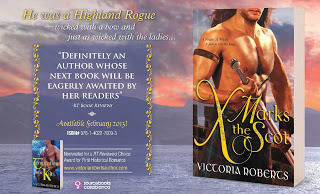
Published on February 07, 2013 04:39
February 6, 2013
Castle of the Week: Blair Castle
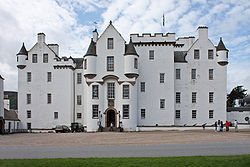 This week's castle is Blair Castle in Scotland. I chose this castle because it plays a part in the 3rd book of my Stolen Bride series--The Highlander's Lady. Blair Castle is the home of my hero, Laird Daniel Murray.
This week's castle is Blair Castle in Scotland. I chose this castle because it plays a part in the 3rd book of my Stolen Bride series--The Highlander's Lady. Blair Castle is the home of my hero, Laird Daniel Murray.The earliest known buildings of the castle date back to 1269, and is known as Cummings or Comyn's Tower. The tower was added to in the 16th century, which is mostly what you'll see today.
The castle was first built by John Comyn--and it wasn't actually his land! He started building while the Earl of Atholl, the actual owner, was away at battle. Naturally, when the earl returned and complained to the king, the tower was given back to the earl. Comyn died a few years later. I guess he supposed the land was fair game since the overlord was away. When the overlord is away...the land interlopers will play... Okay, that was lame :)
The Earl of Atholl, did not however retain his castle long. In fact, he lost his lands to Robert the Bruce when he rebelled. My hero, Daniel is a huge supporter of the Bruce. In fact, he fights alongside him, and his lady--my heroine--Myra Munro, saves the Bruce's life.
Here's where history twists a little in my book. The castle didn't actually come into Murray hands until the 17th century, but for the purposes of my story's setting, I moved that up just a teensy bit (like 400 years...), but as an author, I take creative license to do it. Hope there are no hard feelings!
Today, you can visit the castle for a day tour, camp out, stay at a lodge, have a wedding or function there, enjoy biking, hiking, fishing, have lunch--any number of things.
Take a look at the beautiful gardens:
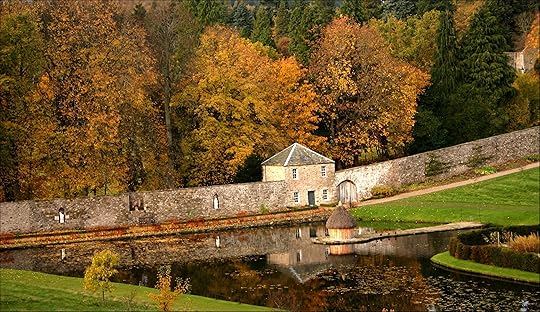 Photograph © Blair Castle
Photograph © Blair Castle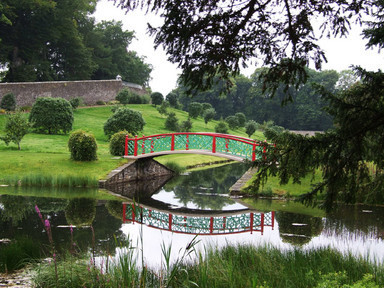 Photograph © Blair Castle
Photograph © Blair Castle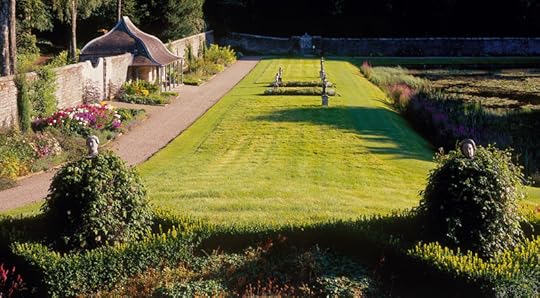 Photograph © Blair CastleIts so majestic, almost like it was built for fairy tales. I'm thrilled that in about a month, I will actually get a chance to visit this castle in person! I will of course post pics from my trip.
Photograph © Blair CastleIts so majestic, almost like it was built for fairy tales. I'm thrilled that in about a month, I will actually get a chance to visit this castle in person! I will of course post pics from my trip.Have you been to Blair? Is it on your list of places to see?
 ABOUT THE BOOK:
ABOUT THE BOOK:BOOK THREE: The Stolen Bride Series
A Highlander tamed…
Laird Daniel Murray seeks adventure, battle and freedom for his countrymen. Putting off his duties as laird—with a promise to his clan he’ll return come spring—Daniel sets off with his men to fight alongside William Wallace and the Bruce. But soon he stumbles across an enchanting lady in need. She tantalizes him with an offer he simply can’t refuse and a desire he attempts to dismiss.
A lady’s passion ignited…
Escaping near death at the treacherous hands of a nearby clan, Lady Myra must find the Bruce and relay the news of an enemy within his own camp. Alone in a world full of danger and the future of her clan at stake, she must trust the handsome, charismatic Highland laird who promises to keep her safe on her journey—and sets her heart to pounding.
Together, Daniel and Myra will risk not only their lives, but their hearts while discovering the true meaning of hope and love in a world fraught with unrest.
READ IT! Amazon / Barnes and Noble
Have you read the other books in the Stolen Bride Series? Check them out!
THE HIGHLANDER'S REWARD
THE HIGHLANDER'S CONQUEST
and coming soon... THE HIGHLANDER'S WARRIOR BRIDE
Published on February 06, 2013 06:35
February 4, 2013
Richard III's Body Found
I woke up this morning to the fascinating news that Richard III's body had been found, and that DNA tests had confirmed it. A truly fascinating story.
Published on February 04, 2013 14:10
February 1, 2013
The Highland Clearances with a Werewolf Perspective By Terry Spear
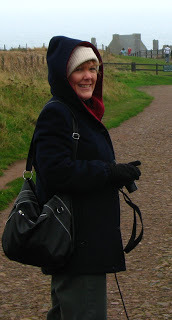 Terry Spear in Scotland
Today I'd like to welcome back, special guest author, Terry Spear to History Undressed! Terry is a USA Today Bestselling author of historical and paranormal romance. Today she's got quite a twist for us! Enjoy!
Terry Spear in Scotland
Today I'd like to welcome back, special guest author, Terry Spear to History Undressed! Terry is a USA Today Bestselling author of historical and paranormal romance. Today she's got quite a twist for us! Enjoy!
The Highland Clearances with a Werewolf PerspectiveBy Terry SpearYep, you heard right!
When I create a fictional story, I try to base it on truth—in part. After all, everyone knows werewolves don’t really exist. Yet, in my Highland wolf stories, werewolves live for centuries, and as such, they have lived through history. When most of us would read about this in history books, they helped to make the history.
Duncan MacNeill is off to Grand Cayman Island to locate the crook who stole his clan/pack’s fortune. While there, he runs into a she-wolf who proves more than intriguing. Not only is she alone, but she’s wearing the Rampant lion on her shirt—and that means? She’s either got Scottish heritage, is a Scot, too, or she just likes all thing Celtic. And he’s interested.
But what he learns is that she’s from a clan that was driven from their homes during the Highland Clearances. See? I really did mean to talk about them!
And his clan is one that took part in ousting crofters from his own lands.
So you see? Instant attraction and instant trouble.
When we visited Scotland, it was beautiful. Lands free of the clutter of homes, cities, people. Just beautiful. If the Highland Clearances hadn’t been part of Scotland’s history, what do you think it would have looked like now? Tons of people filling every square inch of land? Maybe.
What about those who were driven from their homes? They went to Australia, America, Canada, and elsewhere, learning new trades, starting over, some prospering for themselves when they couldn’t have in Scotland. They would never have left, never ventured elsewhere if they hadn’t been forced to.
Yet it was terrible to be uprooted from their homes, many of the dwellings burned.
Acts of Parliament attempted to do away with all things Highland—the playing of the bagpipe, wearing of the tartan, teaching of the Gaelic, gathering of clan members. Where my MacNeills ended up settling—through the treachery of the captain they had paid to take them to North Carolina—reports said that they lived a more “Highland life” than those left behind in Scotland. They gathered, played bagpipes, wore their tartan, and continued their way of life, at least for as long as they wished with nobody dictating to them about it.Religion had been another issue in the Highlands during this time. With moves to North America, the clans could continue to enjoy their faith.
Life was hard in the Highlands way before the Highland Clearances began. For some, they found their new lives way better than their past. For some, it was no better. And others, worse.
It was terrible the way people were uprooted from their homes. But many left to join family who had settled Overseas and there, they continued to be family, unlike where they had lived—often family of those who owned the land, who had fought for them, and now were forced to go.
Lands both in Canada and America were given away free to those who could homestead the land the farther west people moved. Conditions could be harsh, but no more so than in the Highlands. Many of our town names and roads around where I live are Scottish names, including the county I live in: McLennan and the city I live near: Crawford. The Scots were hardy and settled even the wildest areas.
Adversity can make us stronger.
Today, many of those whose families were driven from Scotland during the Highland Clearances now gather at Celtic Fests all over North America. And are proud to be descendants of the hardy Highlanders.
Have you ever been in a situation where you’ve been uprooted—either a job or home situation or even family—and the move you’d never planned to make came to be, and you realized it was the best thing that could ever have happened? Not at the time, though. And it might take some years to see the benefits, but have you?
Thanks to Eliza for having me here today! One lucky commenter will have a chance at winning a copy of A Howl for a Highlander, US or Canada addresses only!
 A HOWL FOR A HIGHLANDER
BY TERRY SPEAR – IN STORES FEBRUARY 2013
A HOWL FOR A HIGHLANDER
BY TERRY SPEAR – IN STORES FEBRUARY 2013A Highland Wolf on a Mission...Duncan MacNeill is hell-bent on catching the thief who's stolen the clan's fortune and run off to Grand Cayman Island. Duncan has rarely left his homeland and he couldn't care less about an island paradise. He never expected to find a beautiful distraction who will show him just how appealing paradise can be...
Meets a Dangerous Distraction...Lone wolf and botanist Shelley Campbell headed to the island to study the old growth forests. She didn't count on meeting a handsome Highlander who can't keep his paws off her.
Praise for Terry Spear:"Intense and swoon-inducing...The chemistry is steamy."—USA Today Happy Ever After
"Fascinating characters and an exciting, action packed plot."—RT Book Reviews, 4 Stars
"Intriguing...The queen of werewolf drama Terry Spear provides a powerful take of love and war."—Midwest Book Review
"Highlanders and werewolves. Be still my heart!"—The Good, the Bad, and the Unread
ABOUT THE AUTHORBestselling and award-winning author Terry Spear has written a couple of dozen paranormal romance novels and two medieval Highland historical romances. Her first werewolf romance, Heart of the Wolf, was named a 2008 Publishers Weekly’s Best Book of the Year, and her subsequent titles have garnered high praise and hit the USA Todaybestseller list. A retired officer of the U.S. Army Reserves, Terry lives in Crawford, Texas, where she is working on her next werewolf romance and continuing her new series about shapeshifting jaguars. For more information, please visit www.terryspear.com, or follow her on Twitter, @TerrySpear. She is also on Facebook at http://www.facebook.com/terry.spear .
Purchase A Howl for a Highlander: AmazonBarnes and NobleBooks-a-MillionIndieBoundChapters/IndigoSourcebooksDiscover a New Love
Published on February 01, 2013 04:40
January 30, 2013
Castle of the Week: Chateau de Chambord
Today's castle of the week has been provided to us by historical romance writer, McKenna Darby. Having grown up visiting my grandparents in Paris, I have an immense love of France, so I'm delighted for today's castle! Enjoy a taste of Chateau de Chambord!
Chambord: The first Renaissance castle of Franceby McKenna Darby
 Chambord from the East corner. Francis I turret is at far left.Paris is a historical novelist’s dream. If you’re a novelist interested in French royalty during the Middle Ages or the Renaissance, however, you can’t follow their trail far without making a trip east to the Loire Valley. France’s kings retreated to the region during the Hundred Years’ War, when England’s control of western France made Paris vulnerable to attack. They stayed long after the war ended, though, and it’s easy to understand why.
Chambord from the East corner. Francis I turret is at far left.Paris is a historical novelist’s dream. If you’re a novelist interested in French royalty during the Middle Ages or the Renaissance, however, you can’t follow their trail far without making a trip east to the Loire Valley. France’s kings retreated to the region during the Hundred Years’ War, when England’s control of western France made Paris vulnerable to attack. They stayed long after the war ended, though, and it’s easy to understand why.
 The foot print of Chambord. Note the central keep with four turrets, typical of medieval castles, and the low curtain wall that outlines the courtyard. The two turrets at the far right, top and bottom, were never completed, rising only as high as the curtain wall. The turret at top left housed Francis' apartments, which were accessed by the external spiral staircase shown below.Few places on earth can rival the abundant forests, scenic rivers and fertile farmlands of the Loire Valley. The numerous castles left behind by its royal visitors – nearly 70 scattered across just three provinces – only add to the region’s beauty. And so it was that, on a recent trip to Paris, I spent a chunk of my weekend on a tour bus bound for Loir-et-Cher and the largest of the Loire Valley’s castles: Chateau de Chambord, which features 440 rooms, 282 fireplaces, and 84 staircases.
The foot print of Chambord. Note the central keep with four turrets, typical of medieval castles, and the low curtain wall that outlines the courtyard. The two turrets at the far right, top and bottom, were never completed, rising only as high as the curtain wall. The turret at top left housed Francis' apartments, which were accessed by the external spiral staircase shown below.Few places on earth can rival the abundant forests, scenic rivers and fertile farmlands of the Loire Valley. The numerous castles left behind by its royal visitors – nearly 70 scattered across just three provinces – only add to the region’s beauty. And so it was that, on a recent trip to Paris, I spent a chunk of my weekend on a tour bus bound for Loir-et-Cher and the largest of the Loire Valley’s castles: Chateau de Chambord, which features 440 rooms, 282 fireplaces, and 84 staircases.
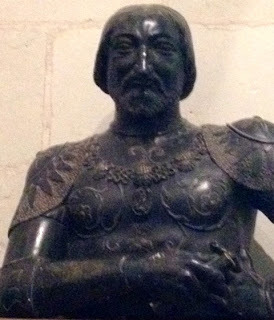 This bust of Francis I in armor is believed to be the most accurate portrayal of the king in his prime.Chambord drew me to the Loire Valley because it was built by Francis I, who was the father-in-law of Catherine de Medici, the Italian noble who helped rule France for more than 40 years, first as queen and then as regent to her three sons. Although most of the court loathed Catherine – ostensibly because she was the daughter of Italian merchants (horrors!) but primarily because she wasn’t French – the king adored his intelligent, witty, and cultured Italian daughter-in-law.Catherine shared Francis’ dream – never achieved – of uniting France and Italy under French rule, as well as her father-in-law’s love of art, books, and architecture. No one knows for certain how long it took for Catherine to recognize their shared interests after she arrived in France to marry the king’s second son, Henri, when they were both just 14. I like to imagine, however, that the discovery occurred the first time Catherine saw Chambord.
This bust of Francis I in armor is believed to be the most accurate portrayal of the king in his prime.Chambord drew me to the Loire Valley because it was built by Francis I, who was the father-in-law of Catherine de Medici, the Italian noble who helped rule France for more than 40 years, first as queen and then as regent to her three sons. Although most of the court loathed Catherine – ostensibly because she was the daughter of Italian merchants (horrors!) but primarily because she wasn’t French – the king adored his intelligent, witty, and cultured Italian daughter-in-law.Catherine shared Francis’ dream – never achieved – of uniting France and Italy under French rule, as well as her father-in-law’s love of art, books, and architecture. No one knows for certain how long it took for Catherine to recognize their shared interests after she arrived in France to marry the king’s second son, Henri, when they were both just 14. I like to imagine, however, that the discovery occurred the first time Catherine saw Chambord.
 View f the courtyard and the staircase that serves the North turret, which housed the personal apartments of Francis I.Francis built Chambord in celebration of his love of Italian Renaissance art and architecture. At the king’s invitation, Leonardo da Vinci visited the site and consulted on the castle’s design. Several historians actually attribute the castle’s distinctive double-helix staircase – two sets of stairs that twine around one another without ever meeting – to the great Italian artist (although the idea is hotly contested and may never be proved). Built as France entered the Renaissance, Chambord’s distinctive architecture blends traditional French medieval forms with classical Italian Renaissance structures. The central keep, for example, is consistent with medieval design, featuring turrets at each corner, an extensive curtain wall and a moat. Inside, however, the building is pure Renaissance.
View f the courtyard and the staircase that serves the North turret, which housed the personal apartments of Francis I.Francis built Chambord in celebration of his love of Italian Renaissance art and architecture. At the king’s invitation, Leonardo da Vinci visited the site and consulted on the castle’s design. Several historians actually attribute the castle’s distinctive double-helix staircase – two sets of stairs that twine around one another without ever meeting – to the great Italian artist (although the idea is hotly contested and may never be proved). Built as France entered the Renaissance, Chambord’s distinctive architecture blends traditional French medieval forms with classical Italian Renaissance structures. The central keep, for example, is consistent with medieval design, featuring turrets at each corner, an extensive curtain wall and a moat. Inside, however, the building is pure Renaissance.
 The "da Vinci" double-helix staircase. Note the wooden beams of the ceiling in one of the four apartments that surround the staircase in a Green cross design on each floor.The “da Vinci” staircase, located at the keep’s center, is built around a column of open air topped by an elaborate spire. The spire, which is pierced by intricate leaded windows, floods all four floors with light. On each of its four stories, the stairs open onto four Greek-cross landings with arched ceilings. Each landing is a complete apartment, a break with the medieval tradition of arranging bedrooms along corridors. Additional suites are housed in each of the turrets, for a total of eight apartments on each floor.
The "da Vinci" double-helix staircase. Note the wooden beams of the ceiling in one of the four apartments that surround the staircase in a Green cross design on each floor.The “da Vinci” staircase, located at the keep’s center, is built around a column of open air topped by an elaborate spire. The spire, which is pierced by intricate leaded windows, floods all four floors with light. On each of its four stories, the stairs open onto four Greek-cross landings with arched ceilings. Each landing is a complete apartment, a break with the medieval tradition of arranging bedrooms along corridors. Additional suites are housed in each of the turrets, for a total of eight apartments on each floor.
 Looking up, inside the da Vinci staircase, toward the decorative tower atop the attic.Chambord’s Italian influence is most evident from the outside, however. Arched pillars, superimposed across the front of the façade, give it a beautiful symmetry that is purely decorative. Double-banded friezes separate the three floors, with each story shorter than the one below it. The towers, steeples, chimneys and lanterns that decorate the keep’s attic, when viewed from the chateau’s front lawn, form the outline of a fantastical town; Francis reportedly commissioned the design to replicate the skyline of Constantinople. (I wasn’t able to snap that picture myself, but you can get a sense of it here, especially in the reflection.)Atop the third floor, a terrace surrounds this entire “city.” At every turn, decorative black slate tiles applied to the white stone give the castle a flamboyant Italian harlequin design. It is easy to imagine the servants, sent to Chambord in advance of the court’s arrival, watching for the approaching royal procession from these ramparts, or craning for a glimpse of the king’s hunting party as it thundered through the nearby forests.
Looking up, inside the da Vinci staircase, toward the decorative tower atop the attic.Chambord’s Italian influence is most evident from the outside, however. Arched pillars, superimposed across the front of the façade, give it a beautiful symmetry that is purely decorative. Double-banded friezes separate the three floors, with each story shorter than the one below it. The towers, steeples, chimneys and lanterns that decorate the keep’s attic, when viewed from the chateau’s front lawn, form the outline of a fantastical town; Francis reportedly commissioned the design to replicate the skyline of Constantinople. (I wasn’t able to snap that picture myself, but you can get a sense of it here, especially in the reflection.)Atop the third floor, a terrace surrounds this entire “city.” At every turn, decorative black slate tiles applied to the white stone give the castle a flamboyant Italian harlequin design. It is easy to imagine the servants, sent to Chambord in advance of the court’s arrival, watching for the approaching royal procession from these ramparts, or craning for a glimpse of the king’s hunting party as it thundered through the nearby forests.
 The decorative tower that tops the da Vinci staircase. Note the black slate used to give the building an Italian harlequin design.Because Chambord was rarely occupied (Francis reportedly spent fewer than seventeen weeks there during his lifetime), the castle was never furnished. With no village nearby, the 2,000-member court had to bring everything it needed – furniture, bedding, tapestries, cooking supplies, food – each time it visited. Today, with the exception of a few apartments outfitted with relatively modern furnishings, visitors to Chambord experience the chateau just as it was between Francis’ visits: utterly empty.
The decorative tower that tops the da Vinci staircase. Note the black slate used to give the building an Italian harlequin design.Because Chambord was rarely occupied (Francis reportedly spent fewer than seventeen weeks there during his lifetime), the castle was never furnished. With no village nearby, the 2,000-member court had to bring everything it needed – furniture, bedding, tapestries, cooking supplies, food – each time it visited. Today, with the exception of a few apartments outfitted with relatively modern furnishings, visitors to Chambord experience the chateau just as it was between Francis’ visits: utterly empty.

The carved Fs stand for Francis. The salamanders were the personal symbol of Francis I, chosen for their mythological ability to regenerate through fire.Even so, evidence of Francis is everywhere, from the FRF initials formed in black slate to the salamanders carved into fireplaces, doors and coffered ceilings. As king, Francis took the salamander as his personal symbol, reflecting the ancient belief that the salamander, like the phoenix, could regenerate through fire – a worthy aspiration for a king who spent most of his reign at war with Spain. A closer view of some of the black slate decorations, plus an engraved shell design, on the fantastical roofline of Chambord.After Francis’ death, his son Henri and daughter-in-law Catherine continued to visit Chambord with their ten children until Henri’s death in a tragic jousting accident. Many years later, when their youngest son’s assassination during the Wars of Religion ended the Valois dynasty, the castle was abandoned. It was rescued by Louis XIV, who used it regularly from 1668 to 1675. Moliere’s famous play “Bourgeois Gentilhomme” had its premiere at Chambord during Louis’ reign.After the French Revolution, Napoleon Bonaparte gave the chateau to a member of his entourage. In 1939, shortly before the outbreak of World War II, the art collections of the Louvre and Compiègne museums (including the Mona Lisa and the Venus de Milo) were hidden at Chambord, where they remained safe until the war ended. In 1991, the chateau became the inspiration for the Beast’s castle in the Walt Disney animated film “Beauty and the Beast.”Now owned by the French government and open to the public, the chateau receives about 700,000 visitors annually.McKenna Darby writes romantic historical novels set during the French Renaissance and the American Civil War. Visit her at http://mckennadarby.com
A closer view of some of the black slate decorations, plus an engraved shell design, on the fantastical roofline of Chambord.After Francis’ death, his son Henri and daughter-in-law Catherine continued to visit Chambord with their ten children until Henri’s death in a tragic jousting accident. Many years later, when their youngest son’s assassination during the Wars of Religion ended the Valois dynasty, the castle was abandoned. It was rescued by Louis XIV, who used it regularly from 1668 to 1675. Moliere’s famous play “Bourgeois Gentilhomme” had its premiere at Chambord during Louis’ reign.After the French Revolution, Napoleon Bonaparte gave the chateau to a member of his entourage. In 1939, shortly before the outbreak of World War II, the art collections of the Louvre and Compiègne museums (including the Mona Lisa and the Venus de Milo) were hidden at Chambord, where they remained safe until the war ended. In 1991, the chateau became the inspiration for the Beast’s castle in the Walt Disney animated film “Beauty and the Beast.”Now owned by the French government and open to the public, the chateau receives about 700,000 visitors annually.McKenna Darby writes romantic historical novels set during the French Renaissance and the American Civil War. Visit her at http://mckennadarby.com
Chambord: The first Renaissance castle of Franceby McKenna Darby
 Chambord from the East corner. Francis I turret is at far left.Paris is a historical novelist’s dream. If you’re a novelist interested in French royalty during the Middle Ages or the Renaissance, however, you can’t follow their trail far without making a trip east to the Loire Valley. France’s kings retreated to the region during the Hundred Years’ War, when England’s control of western France made Paris vulnerable to attack. They stayed long after the war ended, though, and it’s easy to understand why.
Chambord from the East corner. Francis I turret is at far left.Paris is a historical novelist’s dream. If you’re a novelist interested in French royalty during the Middle Ages or the Renaissance, however, you can’t follow their trail far without making a trip east to the Loire Valley. France’s kings retreated to the region during the Hundred Years’ War, when England’s control of western France made Paris vulnerable to attack. They stayed long after the war ended, though, and it’s easy to understand why.
 The foot print of Chambord. Note the central keep with four turrets, typical of medieval castles, and the low curtain wall that outlines the courtyard. The two turrets at the far right, top and bottom, were never completed, rising only as high as the curtain wall. The turret at top left housed Francis' apartments, which were accessed by the external spiral staircase shown below.Few places on earth can rival the abundant forests, scenic rivers and fertile farmlands of the Loire Valley. The numerous castles left behind by its royal visitors – nearly 70 scattered across just three provinces – only add to the region’s beauty. And so it was that, on a recent trip to Paris, I spent a chunk of my weekend on a tour bus bound for Loir-et-Cher and the largest of the Loire Valley’s castles: Chateau de Chambord, which features 440 rooms, 282 fireplaces, and 84 staircases.
The foot print of Chambord. Note the central keep with four turrets, typical of medieval castles, and the low curtain wall that outlines the courtyard. The two turrets at the far right, top and bottom, were never completed, rising only as high as the curtain wall. The turret at top left housed Francis' apartments, which were accessed by the external spiral staircase shown below.Few places on earth can rival the abundant forests, scenic rivers and fertile farmlands of the Loire Valley. The numerous castles left behind by its royal visitors – nearly 70 scattered across just three provinces – only add to the region’s beauty. And so it was that, on a recent trip to Paris, I spent a chunk of my weekend on a tour bus bound for Loir-et-Cher and the largest of the Loire Valley’s castles: Chateau de Chambord, which features 440 rooms, 282 fireplaces, and 84 staircases.
 This bust of Francis I in armor is believed to be the most accurate portrayal of the king in his prime.Chambord drew me to the Loire Valley because it was built by Francis I, who was the father-in-law of Catherine de Medici, the Italian noble who helped rule France for more than 40 years, first as queen and then as regent to her three sons. Although most of the court loathed Catherine – ostensibly because she was the daughter of Italian merchants (horrors!) but primarily because she wasn’t French – the king adored his intelligent, witty, and cultured Italian daughter-in-law.Catherine shared Francis’ dream – never achieved – of uniting France and Italy under French rule, as well as her father-in-law’s love of art, books, and architecture. No one knows for certain how long it took for Catherine to recognize their shared interests after she arrived in France to marry the king’s second son, Henri, when they were both just 14. I like to imagine, however, that the discovery occurred the first time Catherine saw Chambord.
This bust of Francis I in armor is believed to be the most accurate portrayal of the king in his prime.Chambord drew me to the Loire Valley because it was built by Francis I, who was the father-in-law of Catherine de Medici, the Italian noble who helped rule France for more than 40 years, first as queen and then as regent to her three sons. Although most of the court loathed Catherine – ostensibly because she was the daughter of Italian merchants (horrors!) but primarily because she wasn’t French – the king adored his intelligent, witty, and cultured Italian daughter-in-law.Catherine shared Francis’ dream – never achieved – of uniting France and Italy under French rule, as well as her father-in-law’s love of art, books, and architecture. No one knows for certain how long it took for Catherine to recognize their shared interests after she arrived in France to marry the king’s second son, Henri, when they were both just 14. I like to imagine, however, that the discovery occurred the first time Catherine saw Chambord.
 View f the courtyard and the staircase that serves the North turret, which housed the personal apartments of Francis I.Francis built Chambord in celebration of his love of Italian Renaissance art and architecture. At the king’s invitation, Leonardo da Vinci visited the site and consulted on the castle’s design. Several historians actually attribute the castle’s distinctive double-helix staircase – two sets of stairs that twine around one another without ever meeting – to the great Italian artist (although the idea is hotly contested and may never be proved). Built as France entered the Renaissance, Chambord’s distinctive architecture blends traditional French medieval forms with classical Italian Renaissance structures. The central keep, for example, is consistent with medieval design, featuring turrets at each corner, an extensive curtain wall and a moat. Inside, however, the building is pure Renaissance.
View f the courtyard and the staircase that serves the North turret, which housed the personal apartments of Francis I.Francis built Chambord in celebration of his love of Italian Renaissance art and architecture. At the king’s invitation, Leonardo da Vinci visited the site and consulted on the castle’s design. Several historians actually attribute the castle’s distinctive double-helix staircase – two sets of stairs that twine around one another without ever meeting – to the great Italian artist (although the idea is hotly contested and may never be proved). Built as France entered the Renaissance, Chambord’s distinctive architecture blends traditional French medieval forms with classical Italian Renaissance structures. The central keep, for example, is consistent with medieval design, featuring turrets at each corner, an extensive curtain wall and a moat. Inside, however, the building is pure Renaissance.
 The "da Vinci" double-helix staircase. Note the wooden beams of the ceiling in one of the four apartments that surround the staircase in a Green cross design on each floor.The “da Vinci” staircase, located at the keep’s center, is built around a column of open air topped by an elaborate spire. The spire, which is pierced by intricate leaded windows, floods all four floors with light. On each of its four stories, the stairs open onto four Greek-cross landings with arched ceilings. Each landing is a complete apartment, a break with the medieval tradition of arranging bedrooms along corridors. Additional suites are housed in each of the turrets, for a total of eight apartments on each floor.
The "da Vinci" double-helix staircase. Note the wooden beams of the ceiling in one of the four apartments that surround the staircase in a Green cross design on each floor.The “da Vinci” staircase, located at the keep’s center, is built around a column of open air topped by an elaborate spire. The spire, which is pierced by intricate leaded windows, floods all four floors with light. On each of its four stories, the stairs open onto four Greek-cross landings with arched ceilings. Each landing is a complete apartment, a break with the medieval tradition of arranging bedrooms along corridors. Additional suites are housed in each of the turrets, for a total of eight apartments on each floor.
 Looking up, inside the da Vinci staircase, toward the decorative tower atop the attic.Chambord’s Italian influence is most evident from the outside, however. Arched pillars, superimposed across the front of the façade, give it a beautiful symmetry that is purely decorative. Double-banded friezes separate the three floors, with each story shorter than the one below it. The towers, steeples, chimneys and lanterns that decorate the keep’s attic, when viewed from the chateau’s front lawn, form the outline of a fantastical town; Francis reportedly commissioned the design to replicate the skyline of Constantinople. (I wasn’t able to snap that picture myself, but you can get a sense of it here, especially in the reflection.)Atop the third floor, a terrace surrounds this entire “city.” At every turn, decorative black slate tiles applied to the white stone give the castle a flamboyant Italian harlequin design. It is easy to imagine the servants, sent to Chambord in advance of the court’s arrival, watching for the approaching royal procession from these ramparts, or craning for a glimpse of the king’s hunting party as it thundered through the nearby forests.
Looking up, inside the da Vinci staircase, toward the decorative tower atop the attic.Chambord’s Italian influence is most evident from the outside, however. Arched pillars, superimposed across the front of the façade, give it a beautiful symmetry that is purely decorative. Double-banded friezes separate the three floors, with each story shorter than the one below it. The towers, steeples, chimneys and lanterns that decorate the keep’s attic, when viewed from the chateau’s front lawn, form the outline of a fantastical town; Francis reportedly commissioned the design to replicate the skyline of Constantinople. (I wasn’t able to snap that picture myself, but you can get a sense of it here, especially in the reflection.)Atop the third floor, a terrace surrounds this entire “city.” At every turn, decorative black slate tiles applied to the white stone give the castle a flamboyant Italian harlequin design. It is easy to imagine the servants, sent to Chambord in advance of the court’s arrival, watching for the approaching royal procession from these ramparts, or craning for a glimpse of the king’s hunting party as it thundered through the nearby forests.
 The decorative tower that tops the da Vinci staircase. Note the black slate used to give the building an Italian harlequin design.Because Chambord was rarely occupied (Francis reportedly spent fewer than seventeen weeks there during his lifetime), the castle was never furnished. With no village nearby, the 2,000-member court had to bring everything it needed – furniture, bedding, tapestries, cooking supplies, food – each time it visited. Today, with the exception of a few apartments outfitted with relatively modern furnishings, visitors to Chambord experience the chateau just as it was between Francis’ visits: utterly empty.
The decorative tower that tops the da Vinci staircase. Note the black slate used to give the building an Italian harlequin design.Because Chambord was rarely occupied (Francis reportedly spent fewer than seventeen weeks there during his lifetime), the castle was never furnished. With no village nearby, the 2,000-member court had to bring everything it needed – furniture, bedding, tapestries, cooking supplies, food – each time it visited. Today, with the exception of a few apartments outfitted with relatively modern furnishings, visitors to Chambord experience the chateau just as it was between Francis’ visits: utterly empty.

The carved Fs stand for Francis. The salamanders were the personal symbol of Francis I, chosen for their mythological ability to regenerate through fire.Even so, evidence of Francis is everywhere, from the FRF initials formed in black slate to the salamanders carved into fireplaces, doors and coffered ceilings. As king, Francis took the salamander as his personal symbol, reflecting the ancient belief that the salamander, like the phoenix, could regenerate through fire – a worthy aspiration for a king who spent most of his reign at war with Spain.
 A closer view of some of the black slate decorations, plus an engraved shell design, on the fantastical roofline of Chambord.After Francis’ death, his son Henri and daughter-in-law Catherine continued to visit Chambord with their ten children until Henri’s death in a tragic jousting accident. Many years later, when their youngest son’s assassination during the Wars of Religion ended the Valois dynasty, the castle was abandoned. It was rescued by Louis XIV, who used it regularly from 1668 to 1675. Moliere’s famous play “Bourgeois Gentilhomme” had its premiere at Chambord during Louis’ reign.After the French Revolution, Napoleon Bonaparte gave the chateau to a member of his entourage. In 1939, shortly before the outbreak of World War II, the art collections of the Louvre and Compiègne museums (including the Mona Lisa and the Venus de Milo) were hidden at Chambord, where they remained safe until the war ended. In 1991, the chateau became the inspiration for the Beast’s castle in the Walt Disney animated film “Beauty and the Beast.”Now owned by the French government and open to the public, the chateau receives about 700,000 visitors annually.McKenna Darby writes romantic historical novels set during the French Renaissance and the American Civil War. Visit her at http://mckennadarby.com
A closer view of some of the black slate decorations, plus an engraved shell design, on the fantastical roofline of Chambord.After Francis’ death, his son Henri and daughter-in-law Catherine continued to visit Chambord with their ten children until Henri’s death in a tragic jousting accident. Many years later, when their youngest son’s assassination during the Wars of Religion ended the Valois dynasty, the castle was abandoned. It was rescued by Louis XIV, who used it regularly from 1668 to 1675. Moliere’s famous play “Bourgeois Gentilhomme” had its premiere at Chambord during Louis’ reign.After the French Revolution, Napoleon Bonaparte gave the chateau to a member of his entourage. In 1939, shortly before the outbreak of World War II, the art collections of the Louvre and Compiègne museums (including the Mona Lisa and the Venus de Milo) were hidden at Chambord, where they remained safe until the war ended. In 1991, the chateau became the inspiration for the Beast’s castle in the Walt Disney animated film “Beauty and the Beast.”Now owned by the French government and open to the public, the chateau receives about 700,000 visitors annually.McKenna Darby writes romantic historical novels set during the French Renaissance and the American Civil War. Visit her at http://mckennadarby.com
Published on January 30, 2013 05:24
January 29, 2013
Video of the Week: Worst Jobs in History (Victorian era)
The Worst Job in History is one of my favorite series. This video is from the Victorian era jobs. Its just fascinating. This episode is just over 45 min, so you might watch it on your lunch break :) Enjoy!
(PS. A note on YouTube--if you have a Playstation, you can stream YouTube onto your television. It may also work with XBox or Wii as well, like Netflix and Hulu.)
(PS. A note on YouTube--if you have a Playstation, you can stream YouTube onto your television. It may also work with XBox or Wii as well, like Netflix and Hulu.)
Published on January 29, 2013 04:47



